This article will discuss the potential intelligence and military threat that the CCP balloon poses to the US as well as the strategic implications that the balloon represents.
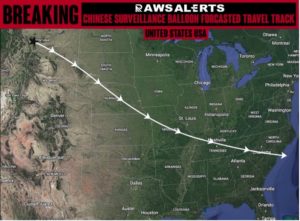 “Lost in Space”
“Lost in Space”
According to the Chinese Communist Party (CCP), a Chinese “lost” weather balloon / civilian airship (sixty feet across or three bus lengths) accidently flew over the United States (Alaska, Idaho, Montana, Wyoming, South Dakota and Nebraska, Kansas, Missouri, Illinois, Kentucky, Tennessee, North and South Carolina) and Canadian territory (Northwest Territory) from 28 January until 4 February 2023. Some on Twitter have called the weather balloon a Chinese space station because it has large solar panels which resemble those powering the International Space Station (356 feet).
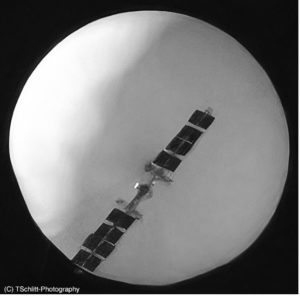 Photo: Tyler Schitt
Photo: Tyler Schitt
Oddities
According to the DOD, the Chinese balloon flew over the US at between 60–70,000 feet in altitude. The USAF U-2 can fly to 70,000 feet according to Lockheed Martin. This Chinese balloon has a larger payload than an American U-2.
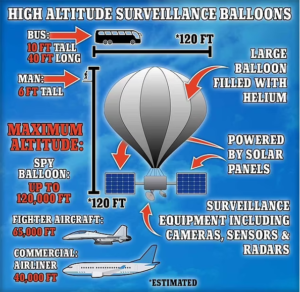 (Source)
(Source)
The Weather Channel noted several issues to compare the Chinese weather balloon with commercial weather balloons. First, commercial weather balloons cover a hundred miles in a flight of a few hours. Before it was shot down, the CCP balloon flew for several days and several thousand miles.
Second, weather balloons’ size start at about six feet and expand to twenty feet across. The CCP balloon is estimated to be about 120 feet across.
Third, commercial weather balloons are not equipped with solar panels; satellites and space stations are equipped with solar panels. Why would a “weather balloon” need power for a long period of time?
Intelligence Collection
This Pentagon called the Chinese object a surveillance balloon. Surveillance refers to intelligence collection. In effect, it is an unmanned aircraft, flying at the altitude of a U-2 aircraft with sensors that collect information.
What kinds of intelligence could an object flying at 70,000-feet collect? According to Air Force technology website, the U-2 has signals intelligence (SIGINT) and imagery intelligence (IMINT) capabilities.
What information can the CCP collect if it has those capabilities on its spy balloon?
SIGINT
SIGINT is composed of several components to include communications intelligence (COMINT), electronic intelligence (ELINT) and foreign instrumentation signals intelligence (FISINT) according to US intelligence.
For example, the sensors on the balloon can collect radar (ELINT) coming from civilian and military sources, which would be useful for the PLA Air Force to design a flight path to avoid US radars and deliver nuclear weapons to specific targets throughout the US.
As the balloon traversed Canada and the US, the sensors onboard could fill gaps in the PLA’s understanding of the command-and-control communication system (COMINT) used by the combined US-Canadian North American Aerospace Defense Command (NORAD).
IMINT
The CCP can use imagery intelligence (IMINT) to refine geo-spatial data on which targets to destroy during wartime. The location of a target is not only a coordinate on a map; the “location” includes, for example, the altitude of the target above (or below) sea level, whether there are buildings or other obstacles above the target, types of soil, and whether the target is underground. Many other details are needed to ensure that the target is destroyed or disabled.
The CCP spy balloon flew over Malmstrom Air Force Base (AFB), Montana, that maintains and secures 150 Minuteman III intercontinental ballistic missiles (ICBMs) each armed with one (of two optional types) nuclear warhead that is 12–22 times more powerful than the nuclear weapons the US used in WWII. Therefore, collecting precise targeting intelligence on US nuclear missile silos would be useful to PLA targeteers planning a first-strike attack.
The same overflight threat could be applied to Whiteman AFB, MO – sixty miles from Kansas City, Missouri. Whiteman AFB has the USAF 509th Bomb Wing which supports, maintains and operates the US only stealth bomber– the B-2 Spirit. The bomb wing’s mission is to “to execute strategic nuclear operations, lethal global strike and combat support – anytime, anywhere!”
MASINT
Measurement and Signature Intelligence (MASINT) is information produced by quantitative and qualitative analysis of physical attributes of targets and events to characterize, locate, and identify them.
The balloon could carry specially designed scientific pods that could have been dropped throughout its flight path such as the famous “Heavy Tea” mission conducted by the Black Bat Squadron (Republic of China / Taiwan) described below. These pods could be used for a variety of longer term collection efforts against the US and Canada, for example, post-strike battle damage assessment of certain targets.
Other Possibilities—Weapons
In addition to its role as an unmanned reconnaissance balloon carrying intelligence collection systems, this balloon could be a weapons delivery vehicle and carry other payloads, such as precision-guided bombs or missiles with conventional and unconventional (nuclear, biological, or chemical weapons) warheads.
For example, the CCP balloon’s proximity to Offutt AFB, Nebraska should be an area of concern. The US Strategic Command (USSTRATCOM) is located at Offutt AFB, where it commands and controls all nuclear weapons (ground, air and naval) and is responsible for US missile defense, and other mission areas. If the balloon had an electromagnetic pulse (EMP) weapon on board, USSTRATCOM’s ability to communicate with its component commands could be impeded. The PLA could place whatever it wanted in the balloon’s payload.
Historical Examples
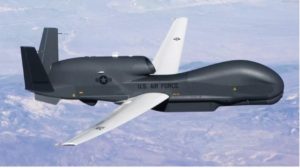 Global Hawk (Source)
Global Hawk (Source)
20 June 2019: Iranians shot down a USAF Global Hawk reconnaissance aircraft in the Arabian Gulf operating in international airspace. President Trump could have responded by bombing the Iranian surface-to-air missile unit that shot down the $200 million USAF aircraft. Instead, he later ordered a drone strike six months later that killed Major-General Qassem Soleimani, head of the Iranian Quds Force and Iraqi militia commander Abu Mahdi al-Muhandis, on 3 January 2020 at the Baghdad Airport in Iraq.
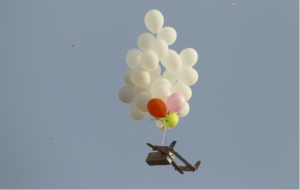 Hamas balloons with explosives (source)
Hamas balloons with explosives (source)
2018–current: In 2018, Hamas began sending balloons and kites carrying explosives and incendiaries from the Gaza Strip into Israel. The resulting fires destroyed large swaths of farm land as well as destroyed nature preserves. Israel developed a solution called “Light Saber” laser anti-balloon system that pops the balloons in the sky before they get too far into Israel. The system is pictured below.
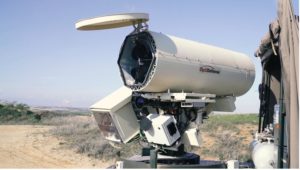 Light Saber System (Source)
Light Saber System (Source)
Although the incendiary balloons cause agricultural and environmental damage, the IDF is concerned that these balloons could become vectors in the future for chemical or biological weapons.
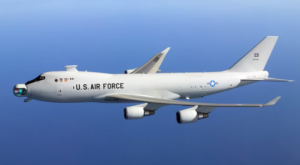 USAF Airborne Laser (Source)
USAF Airborne Laser (Source)
The USAF program for an airborne laser (ABL) on a modified Boeing 747 began in 1996. It was cancelled in 2012. In 2022, Lockheed Martin delivered to the USAF a new airborne laser capability called LANCE. An airborne laser program should be able to force the CCP balloon to the ground / sea.
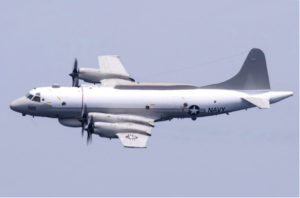 US Navy EP-3E (Source)
US Navy EP-3E (Source)
1 April 2001: The PLA Air Force and the US Navy had a confrontation over international waters near Hainan Island where two PLA Navy J-8s intercepted a US Navy EP-3E reconnaissance aircraft. During the interception, one PLAAF pilot conducted an unsafe maneuver that caused his plane to crash (he died) and damaged the EP-3E which had to do an emergency landing on Hainan. After being detained and interrogated for eleven days, the PLA allowed the 24 US Navy aircrew to return but delayed returning the EP-3E until they had completed exploiting it and returned it cut-up into pieces.
1957–1974 Black Cat and Black Bat Squadrons flights over the PRC: A lesser-known historical example were the Black Cat and Black Bat aircraft that the PLA shot down while flying over the PRC.
The Black Cat Squadron (35th Squadron) U-2 and the older RB-57 aircraft were flown by Republic of China (ROC) / Taiwan pilots trained by the USAF; the CIA managed the planes and the intelligence collected. Of the 220 U-2 missions flown, the squadron lost six USAF U-2s of which five were shot down by the PLA overflying the PRC, killing four ROC pilots. Two ROC pilots were captured and released after several decades of incarceration. [An excellent overview of the two programs is found here].
The Black Bat Squadron (34th Squadron) had ROC aircrew flying USAF or US Navy aircraft low-level missions into the PRC. From 1953 to 1969, the squadron carried out 838 reconnaissance missions, lost 15 aircraft, and 148 ROC military personnel were killed. Operation “Heavy Tea” was one of the most famous missions accomplished. The crew flew a specially configured C-130 for low-level flight and dropped two remote CIA sensors (a seismic monitor and an air analyzer) near the PRC nuclear test site on 19 May 1969. These sensors provided critical information regarding two nuclear weapons tests that helped the US and the rest of the world understand the CCP threat.
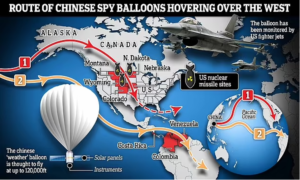 (Source)
(Source)
Second CCP Spy Balloon over Latin America
News reporting from Latin America indicated that a second CCP spy balloon flew over Costa Rica, Columbia, and Venezuela. All the concerns raised in the North American CCP spy balloon example also relate to the path of the second one.
You Choose
Which historical precedent would you recommend in response to future CCP balloons or other CCP Grey Zone activities against your country?
Part 2
In this section, we discuss the strategic implications and questions concerning the CCP reconnaissance balloon overflight of US national airspace.
Three Warfares
In 2003, the CCP’s Central Military Commission announced three new types of warfare capabilities: legal warfare (lawfare), psychological warfare, and media warfare. Each one of these warfares will be used to examine the importance of the CCP’s spy balloon beyond the intelligence dimension.
Lawfare
The passage of the CCP balloon is a violation of international law, specifically U.S. sovereign territory. The sanctity of sovereign airspace is an international rule of law, which the PRC flagrantly violated. Does allowing passage of balloons through sovereign airspace without a direct military intervention give the PRC the means to employ hybrid warfare to claim a legal exception to balloon passage? Even if such a claim would not stick, it would suggest the U.S. is hesitant to respond to a direct provocation making the legal case for the passage a useful lawfare tool. This has implication for U.S. territories within striking distance of mainland China, including Guam
Psychological Warfare
Much is being made of the “overreaction” by the public to the balloon’s incursion, yet it is the lack of immediacy that allowed the psychological aspect to escalate. The failure or hesitancy to directly deal with this intrusion has a negative effect on our allies and Taiwan in particular. If the U.S. cannot decidedly deal with a violation of its sovereignty by the PRC, it creates doubt as to whether it respond decisively to its NATO Article V commitments, or whether can Taiwan be assured the U.S. will resolutely respond to an invasion by the PRC.
From its impact on the U.S. public, this is worse than a Sputnik moment. Sputnik-1 quashed Soviet claims of sovereignty in outer space and gave rise to a standard of international law that permitted the overflight of sovereign nations from space. However, the ensuing alarm from the Soviet success eclipsed that important norm. Indecisiveness that allowed the PRC to overfly U.S. territory, especially over U.S. ICBM fields, without immediate intervention, creates doubt and potentially fosters panic in the general population, which erodes confidence in the government’s ability to ensure national security.
Media Warfare
The media has been following this story closely and the PRC will use its media and Western media, including social media, to further erode confidence in the ability of political leaders to respond to a provocation. Moreover, China will use media to muddy its culpability and cast blame for the incident on the U.S. NGOs and academia.
Strategic implications
- Violation of U.S. airspace was doubtless timed for Secretary of State Blinken’s Beijing summit. Beijing is likely gauging U.S. resolve ahead of the meeting. Indeed, it did have the political effect of the meeting being postponed indefinitely and makes it less likely there will be a thawing of relations.
- The balloon overflight erodes confidence in U.S. nuclear deterrence. Permitting the PRC to violate U.S. airspace and fly over sensitive military installations, including installations basing two legs of the nuclear triad, threatens the integrity of the U.S. land-based nuclear arsenal through the gathering of SIGINT, digital terrain mapping and other intelligence gathering as noted above. The PRC’s apparent development of a fractional-orbital bombardment system, which employs hypersonic technology, would benefit directly from this.
- The overflight and attendant violation of the airspace of a sovereign power is provocative and suggests the PRC continues on a steady course that will continue to grow more belligerent and emboldened to take even more risky actions, including mount an invasion of Taiwan before the politically baked-in date of 2027.
- The risk-averse decision-making process that permitted the incursion and overflight raises questions about how the U.S. will approach other provocative actions by the PRC. Will the U.S. respond in a manner that takes into consideration the risks but decides acting is in the better interest of national security, or will it hesitate to act because the fear of potential detrimental political impact outweighs the national security benefit of taking decisive action?
A final note
The Gateway Pundit overlayed a graphic of key military bases along the path of the balloon.
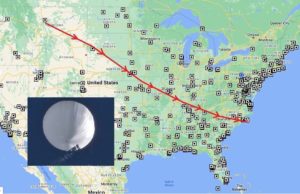 (Source)
(Source)
“Here is a list of the US Military bases in the path of the China Spy Balloon.
** Malmstrom Air Force Base – Montana – home of 341st Missile Wing
** Ellsworth Air Force Base – South Dakota – home of 28th Bomb Wing
** Joe Foss Field ANG – South Dakota – home of 114th Fighter Wing
** Sioux City ANG – Iowa – national guard base
** Offutt Air Force Base -Nebraska – headquarters US Strategic Command
** Camp Ashland – Nebraska
** Lincoln ANG – Nebraska
** Whiteman Air Force Base – Missouri – home of [B-2 bombers]
** Fort Leonard Wood – Missouri – Army training installation
** St. Louis Army Human Resources – St. Louis, MO
** Scott Air Force Base – Illinois – home of the Air Mobility Command
** Fort Campbell – Tennessee – home of the Screaming eagles, the 101st Airborne
** Nashville ANG – Tennessee
** Smyrna ANG – Tennessee
** Houston Barracks – Tennessee
** McGhee Tyson ANG – Tennessee
** Pope Air Force Base – North Carolina – Air Mobility Command
** Fort Bragg – North Carolina – one of the largest military installations in the world [home of US Army Special Forces]
** MCAS New River – North Carolina
** Camp Lejeune – North Carolina – [USMC] military training facility
** US Coast Guard Station Fort Macon – [North Carolina]
This was an unprecedented national security threat.”
Guermantes Lailari is a retired U.S. Air Force Foreign Area officer specializing in the Middle East and Europe as well as counterterrorism, irregular warfare, and missile defense. He was a USAF attaché in the Middle East, served in Iraq, and holds advanced degrees in international relations and strategic intelligence. He was a Taiwan Fellow in 2022 and is now a Visiting Scholar at National Chengchi University in the Republic of China (ROC) / Taiwan. He also serves on the Jewish Policy Center’s Board of Fellows.
Michael J. Listner is an attorney and subject matter expert on outer space law, policy and lawfare/hybrid warfare strategy. Michael is the Founder and Principal of the consultation firm/legal and policy think-tank, Space Law and Policy Solutions and the author and editor of the space law and policy briefing-letter, The Précis.





